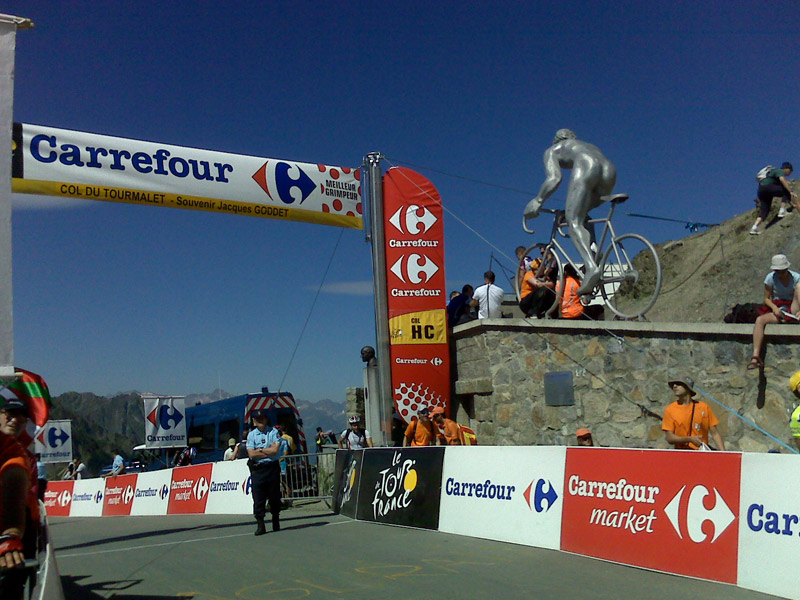I had a few reasons for wanting to ride the 1st Annual Assault on Pikes Peak. One is the fear of Towne’s Pass, a 13 mile, 3900 foot climb that starts at mile 200 of Furnace Creek 508. I thought the Pikes Peak climb, 7700 feet in 24.5 miles would be good training for that. To simulate the fatigue of mile 200, I rode a fast 200k the day before. Second, bikes aren’t normally allowed on the road to Pikes Peak so the opportunity to bike up while the road was closed to cars sounded like fun. Third, although I’ve lived less than 100 miles from Pikes Peak for 19 years, I’ve never been to the top, or to the top of any mountain over 14,000 feet. Bike, instead of hike up, even better!
In spite of the previous day’s 200k ride, I felt surprisingly good on Sunday morning. By the 7:00am start in Manitou Springs the sun was shining and I left my arm warmers in the car. I hesitated, remembering I’d worn my jersey with very large back pockets just so I’d have room for things like that, and thinking that the temps might be considerably colder on the mountain, but decided I’d be working hard so I’d stay warm. I started at the very back of the pack with nearly all 260+ riders in front of me because I didn’t want to sprint off the start line, and it’s motivating for me to work my way past other riders. We quickly hit steeper grades when leaving Manitou and heading onto Highway 24 and I was spinning easily in my 24.5 inch low gear.
It was a beautiful morning and a beautiful ride with no vehicles on the road other than those associated with the race. Before Glen Cove we arrived at the two and a half mile unpaved stretch and the wind started to pick up. Oh yeah, wind. I’d been expecting high winds on the ride, but hadn’t given it much thought for the first 15 miles. After Glen Cove we started up switchbacks and the wind got stronger. In fact, the wind seemed to increase in ferocity the entire way up, then strangely, at the summit, it was relatively calm. The race summary on OutThere.com reported the wind speed as 30-45mph. I would have guessed in the 20’s, but I’m not good at estimating since the wind speeds recorded in my area seem to be measured from some calmer-than-average spot and I do not own an anemometer. Needless to say the windchill felt significantly colder than the predicted high 40’s-50 degree temperature and I was wishing for my arm warmers. Since I didn’t bring them I had a good reason to stay on my bike and keep moving.
Although I live at 9000 feet, and regularly ride up to 10,000, I know from the years I was training for ultraruns and frequently went up to 12,500 feet, that above 12,000 feet things start getting weird for me. Once I saw the sign for 12,000+ feet elevation, I started paying more attention to my heart rate and stayed just below 80%. Actually I found the altitude a little easier to deal with on my bike than hiking, probably because I was sitting down. Still between the wind, the exposed mountain road with no guard rail, and lower oxygen levels it was a bit surreal. I was anxious to get to the top and get my drop bag with warm clothes, but kept a moderate pace, knowing if I pushed too hard and had to stop, I’d be even colder.
The summit seemed to come quickly. Although in reality a lot of time passed climbing at such a slow speed. My official time was 3:54. I’d hoped to finish in under 4 hours so I was happy. I found my drop bag, bundled up and started back down. The first few thousand feet of the descent were the only part of the ride I did not enjoy. Hopefully I will get to bike up Pikes Peak again. It was a really nice way to spend the morning!
There were a number of challenged athletes participating in the 2010 Assault on Pikes Peak, including the handcyclist pictured here. Yes, he rode all the way to the top!! Several were disable veterans of the wars in Iraq and Afghanistan. I’m raising money for the Challenged Athletes Foundation in conjunction with riding Furnace Creek 508. If you’d like to help these and other disabled athletes you can donate here.
Hill Junkie wrote a far more dramatic and interesting report about Pikes Peak with photos! I don’t agree that there were any 13% grades on the ride, but with the headwind the 8-10% sections felt much steeper. He also discusses the electric bikes that were used by several riders. I think Pikes Peak offered a good demonstration of the capabilities of electric bikes, but as far as the results, all electric bikes should probably be treated as a separate division.


















